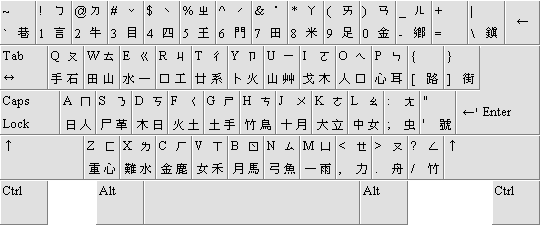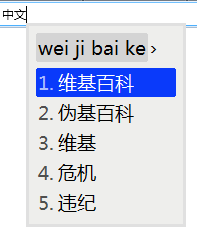|
Chinese BASIC
Chinese BASIC () is the name given to several Chinese-localized versions of the BASIC programming language in the early 1980s. Versions At least two versions of Chinese BASIC were modified Applesoft BASIC that accepted Chinese commands and variables. They were built into some Taiwan-made Apple II clones. One of these was shipped with the best-selling Multitech Microprofessor II (known as Acer today). Another version was shipped with MiTAC's Little Intelligent Computer (). In addition to Apple II clones, Multitech also developed a Zilog Z80-based port of the Chinese BASIC for its own line of high-end computers. Example In a typical Chinese BASIC environment, Chinese and English commands are interchangeable. It may also accept Chinese and Latin alphabet variables. For example, you may use in line 50, in line 200 and in line 250. They all do the same thing—to print out the value of on screen. This program calculates the sum of . The Chinese characters used as variables a ... [...More Info...] [...Related Items...] OR: [Wikipedia] [Google] [Baidu] |
Chinese Language
Chinese (, especially when referring to written Chinese) is a group of languages spoken natively by the ethnic Han Chinese majority and many minority ethnic groups in Greater China. About 1.3 billion people (or approximately 16% of the world's population) speak a variety of Chinese as their first language. Chinese languages form the Sinitic branch of the Sino-Tibetan languages family. The spoken varieties of Chinese are usually considered by native speakers to be variants of a single language. However, their lack of mutual intelligibility means they are sometimes considered separate languages in a family. Investigation of the historical relationships among the varieties of Chinese is ongoing. Currently, most classifications posit 7 to 13 main regional groups based on phonetic developments from Middle Chinese, of which the most spoken by far is Mandarin (with about 800 million speakers, or 66%), followed by Min (75 million, e.g. Southern Min), Wu (74 million, e ... [...More Info...] [...Related Items...] OR: [Wikipedia] [Google] [Baidu] |
Non-English-based Programming Languages
Non-English-based programming languages are programming languages that do not use keywords taken from or inspired by English vocabulary. Prevalence of English-based programming languages The use of the English language in the inspiration for the choice of elements, in particular for keywords in computer programming languages and code libraries, represents a significant trend in the history of language design. According to the HOPL online database of languages, out of the 8,500+ programming languages recorded, roughly 2,400 of them were developed in the United States, 600 in the United Kingdom, 160 in Canada, and 75 in Australia. Thus, over a third of all programming languages have been developed in countries where English is the primary language. This does not take into account the usage share of each programming language, situations where a language was developed in a non-English-speaking country but used English to appeal to an international audience (see the case of Py ... [...More Info...] [...Related Items...] OR: [Wikipedia] [Google] [Baidu] |
Byte
The byte is a unit of digital information that most commonly consists of eight bits. Historically, the byte was the number of bits used to encode a single character of text in a computer and for this reason it is the smallest addressable unit of memory in many computer architectures. To disambiguate arbitrarily sized bytes from the common 8-bit definition, network protocol documents such as The Internet Protocol () refer to an 8-bit byte as an octet. Those bits in an octet are usually counted with numbering from 0 to 7 or 7 to 0 depending on the bit endianness. The first bit is number 0, making the eighth bit number 7. The size of the byte has historically been hardware-dependent and no definitive standards existed that mandated the size. Sizes from 1 to 48 bits have been used. The six-bit character code was an often-used implementation in early encoding systems, and computers using six-bit and nine-bit bytes were common in the 1960s. These systems often had memory wo ... [...More Info...] [...Related Items...] OR: [Wikipedia] [Google] [Baidu] |
Chinese Input Methods For Computers
Chinese input methods are methods that allow a computer user to input Chinese characters. Most, if not all, Chinese input methods fall into one of two categories: phonetic readings or root shapes. Methods under the phonetic category usually are easier to learn but are less efficient, thus resulting in slower typing speeds because they typically require users to choose from a list of phonetically similar characters for input, whereas methods under the root shape category allow very precise and speedy input but have a steep learning curve because they often require a thorough understanding of a character's strokes and composition. Other methods allow users to write characters directly onto touchscreens, such as those found on mobile phones and tablet computers. History Chinese input methods predate the computer. One of the early attempts was an electro-mechanical Chinese typewriter Ming kwai () which was invented by Lin Yutang, a prominent Chinese writer, in the 1940s. It assig ... [...More Info...] [...Related Items...] OR: [Wikipedia] [Google] [Baidu] |
QWERTY
QWERTY () is a keyboard layout for Latin-script alphabets. The name comes from the order of the first six keys on the top left letter row of the keyboard ( ). The QWERTY design is based on a layout created for the Sholes and Glidden typewriter and sold to E. Remington and Sons in 1873. It became popular with the success of the Remington No. 2 of 1878, and remains in ubiquitous use. History The QWERTY layout was devised and created in the early 1870s by Christopher Latham Sholes, a newspaper editor and printer who lived in Kenosha, Wisconsin. In October 1867, Sholes filed a patent application for his early writing machine he developed with the assistance of his friends Carlos Glidden and Samuel W. Soulé. The first model constructed by Sholes used a piano-like keyboard with two rows of characters arranged alphabetically as shown below: - 3 5 7 9 N O P Q R S T U V W X Y Z 2 4 6 8 . A B C D E F G H I J K L M Sholes struggled for the next five years to perfect his ... [...More Info...] [...Related Items...] OR: [Wikipedia] [Google] [Baidu] |
Cangjie Method
The Cangjie input method (Tsang-chieh input method, sometimes called Changjie, Cang Jie, Changjei or Chongkit) is a system for entering Chinese characters into a computer using a standard computer keyboard. In filenames and elsewhere, the name Cangjie is sometimes abbreviated as cj. The input method was invented in 1976 by Chu Bong-Foo, and named after Cangjie (Tsang-chieh), the mythological inventor of the Chinese writing system, at the suggestion of Chiang Wei-kuo, the former Defense Minister of Taiwan. Chu Bong-Foo released the patent for Cangjie in 1982, as he thought that the method should belong to Chinese cultural heritage. Therefore, Cangjie has become open-source software and is on every computer system that supports traditional Chinese characters, and it has been extended so that Cangjie is compatible with the simplified Chinese character set. Cangjie is the first Chinese input method to use the QWERTY keyboard. Chu saw that the QWERTY keyboard had become an inter ... [...More Info...] [...Related Items...] OR: [Wikipedia] [Google] [Baidu] |
Variable (programming)
In computer programming, a variable is an abstract storage location paired with an associated symbolic name, which contains some known or unknown quantity of information referred to as a '' value''; or in simpler terms, a variable is a named container for a particular set of bits or type of data (like integer, float, string etc...). A variable can eventually be associated with or identified by a memory address. The variable name is the usual way to reference the stored value, in addition to referring to the variable itself, depending on the context. This separation of name and content allows the name to be used independently of the exact information it represents. The identifier in computer source code can be bound to a value during run time, and the value of the variable may thus change during the course of program execution. Variables in programming may not directly correspond to the concept of variables in mathematics. The latter is abstract, having no reference to a phy ... [...More Info...] [...Related Items...] OR: [Wikipedia] [Google] [Baidu] |
Hanzi
Chinese characters () are logograms developed for the writing of Chinese. In addition, they have been adapted to write other East Asian languages, and remain a key component of the Japanese writing system where they are known as ''kanji''. Chinese characters in South Korea, which are known as ''hanja'', retain significant use in Korean academia to study its documents, history, literature and records. Vietnam once used the '' chữ Hán'' and developed chữ Nôm to write Vietnamese before turning to a romanized alphabet. Chinese characters are the oldest continuously used system of writing in the world. By virtue of their widespread current use throughout East Asia and Southeast Asia, as well as their profound historic use throughout the Sinosphere, Chinese characters are among the most widely adopted writing systems in the world by number of users. The total number of Chinese characters ever to appear in a dictionary is in the tens of thousands, though most are graph ... [...More Info...] [...Related Items...] OR: [Wikipedia] [Google] [Baidu] |
Keyboard Layout Chinese Traditional
Keyboard may refer to: Text input * Keyboard, part of a typewriter * Computer keyboard ** Keyboard layout, the software control of computer keyboards and their mapping ** Keyboard technology, computer keyboard hardware and firmware Music * Musical keyboard, a set of adjacent keys or levers used to play a musical instrument ** Manual (music), a keyboard played with hands, as opposed to; ** Pedalboard or pedal keyboard, played with feet ** Enharmonic keyboard, one of several layouts that incorporate more than 12 tones per octave * Keyboard instrument, a musical instrument played using a keyboard ** Synthesizer A synthesizer (also spelled synthesiser) is an electronic musical instrument that generates audio signals. Synthesizers typically create sounds by generating waveforms through methods including subtractive synthesis, additive synthesis and ..., an electronic keyboard ** Electronic keyboard, a synthesizer See also * Input method * Keypad {{disambiguati ... [...More Info...] [...Related Items...] OR: [Wikipedia] [Google] [Baidu] |



